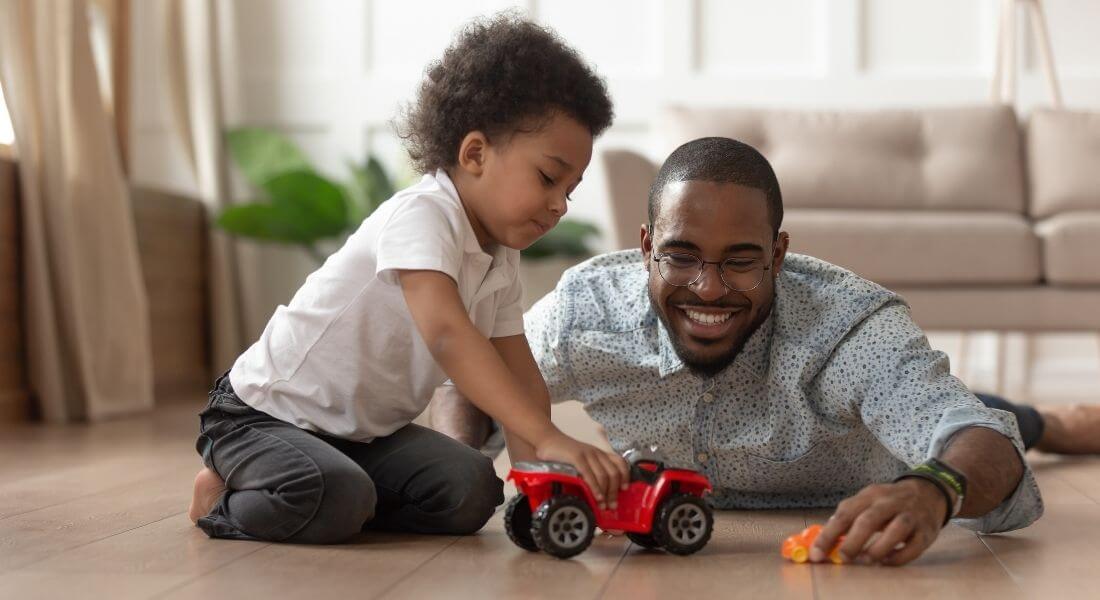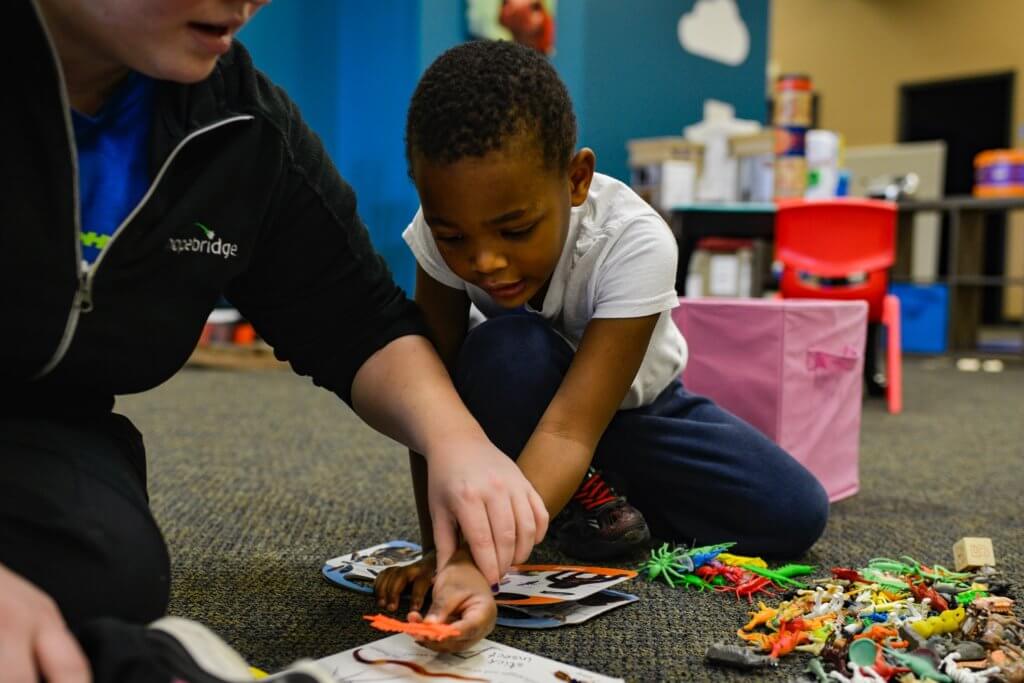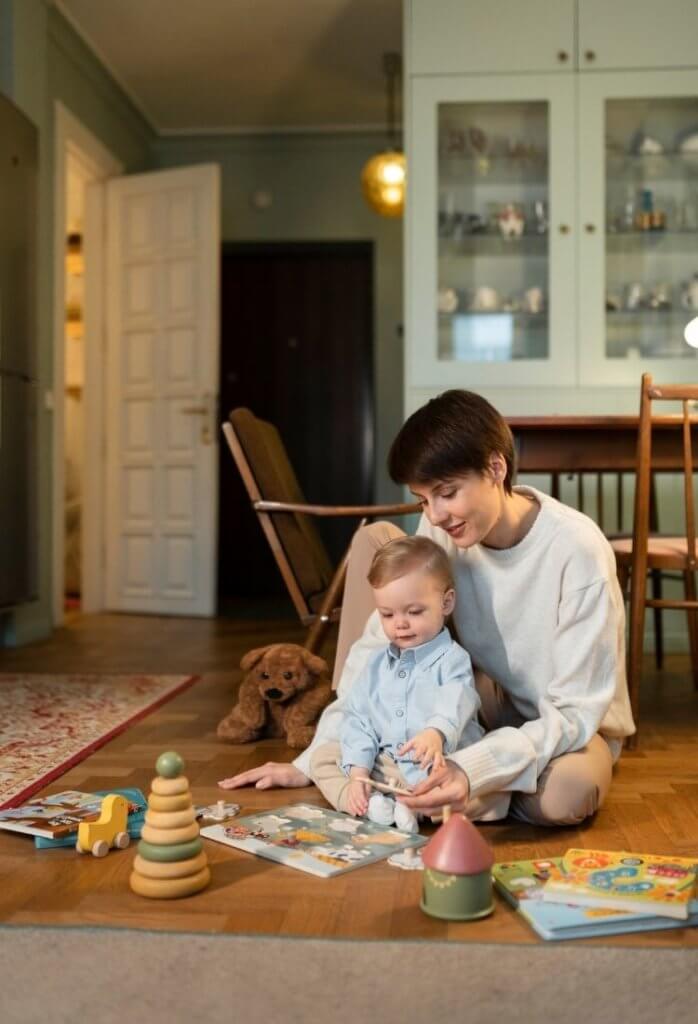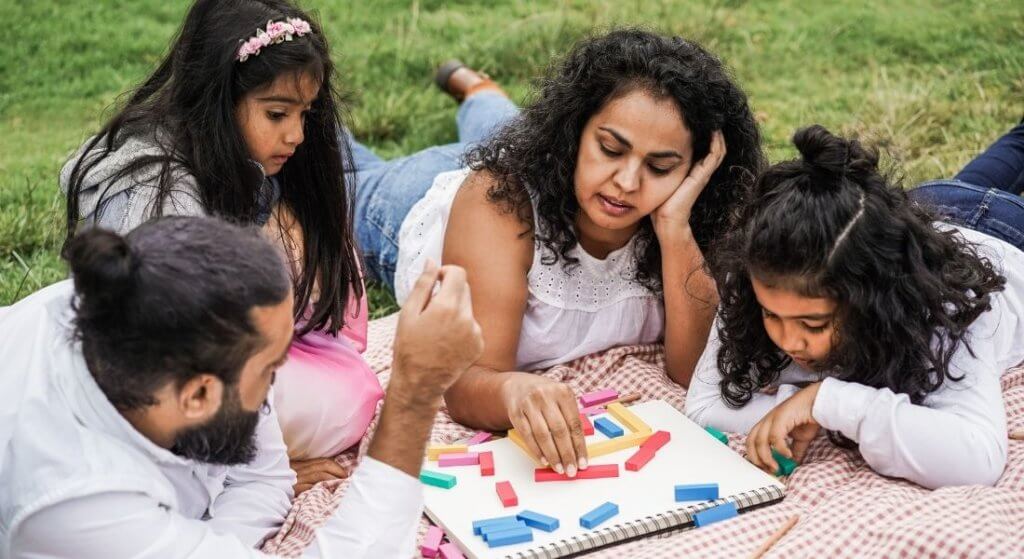Connection Through Play: Tips for Playing with Children with Autism
February 16, 2022
February 16, 2022

Playing seems intuitive, right? When we were kids, many of us could barely wait a minute to dig into our new toys, so it may come as a surprise when our own children are not as excited by their shiny new games, gadgets and stuffed animals. It’s not uncommon, however, for some children – especially those with autism spectrum disorder (ASD) – to require help in learning how to play.

The trouble is, now as adults, we often forget how to play, too, and could use extra support in playing with children. In fact, according to a research study (Kenzer, et al., 2018)**, a majority of parents do not know how to engage their children through play. During a five-minute period, parents were asked to get on the ground with their children while researchers recorded their playtime. One parent sat watching their child, while another scrolled their phone during this period. Then, after parent training in which parents learned to naturalistically play with their kids, researchers found that parents were more bonded with their children.
There is no shame in asking for help in this area, as many parents are in the same position. Evidence-based practices, like applied behavior analysis (ABA therapy), can be a great resource for not only assisting children in everyday tasks, behaviors and communication, but also in learning to play and better connect with their loved ones.

At Hopebridge, we don’t only provide your child with therapy, we want to give you – the most important person in their life! – the tools to bond with them at home. To provide more support around play beyond our center walls, we turned to one of our board certified behavior analysts (BCBA), Kimberly Heinemann, from our autism therapy center in Woodstock, GA. She breaks down why play is so significant, as well as offers a range of ideas for playing with your child in ways that will expand upon their skills and your relationship with them.
Find out more from Kimberly about:
Play is a vehicle for learning. We can embed targets into play to inadvertently work on skills. This is especially true for younger kiddos, though I’ve also witnessed it in action for older patients and students I encountered in my experience as a behavior analyst and formerly as a special educator.
Beyond entertainment, some of the top benefits of play include:

Play is a good starting point for parents and therapists to work on foundational and functional skills. It’s a great way to work on concepts and goals, and many times, the kids have so much fun that they don’t realize we’re placing demands. From sorting and identifying colors, to labeling objects and understanding the purpose of specific items, the possibilities of learning within play are endless.
In addition to using play as part of therapy, we can also use ABA therapy to teach play skills. It may sound like a “Catch-22,” but some kiddos need to be systematically taught how to play due to barriers related to autism. Restrictive interests, repetitive behaviors, a lack of symbolic play, and/or challenges with sharing, attending or tolerating someone in their space can all hinder playtime. For example, a child may take a toy airplane, flip it over and solely spin the wheels, rather than flying it through the air. Through ABA therapy, we can work with that child to open even more opportunities for playing with that airplane.
Now that you know more about why you should play with your kiddo, you may be wondering how to start, especially if they do not seem to play in the same ways you are accustomed to with neurotypical children. Here is our number-one tip on where to begin: Get on the ground!
Literally and figuratively, we need to get on their level. Getting on the ground to play with children allows parents to fully engage in the activity. At this level, we can observe things a little closer, as well as model the activity. You want tummy time? Get down there and model it. Show them how you can play with trucks or do the puzzle on your belly. When we’re on a chair or the couch, it’s more difficult to model play. Sitting on the floor with them allows us to better expand upon their play schemes. For instance, if they are doing something repetitive with the toys, we can not only follow their lead, but add onto what they are doing.
Playtime on the floor is also less demanding. Think about it: From their viewpoint, you’re a gigantic adult and they’re a little toddler or preschooler. It can be intimidating. Getting on their eye level brings down the demands and makes it more play-based and fun.
For some, playing comes easy, but for others, it can take practice. That goes for kids and parents. If you need a little nudge, here are 10 actionable tips and steps to get started with your kiddo or enhance your playtime:
1. Have a designated play space.
Set up an organized area that is free from other factors. Whatever you’re targeting should be what’s there. No TV, no messy living area, no siblings doing homework in the same room, no iPad on the kitchen table that they’ll gravitate towards.
2. Get silly.
I tell my therapists, “If I walk by and you don’t look silly, you’re not doing your job!” Add in sound effects, body movements. Just let go and see where the play takes you—have fun with it!

3. Begin with highly preferred toys.
To start, you need things that will keep their interest. When trying to connect through play, you might need to isolate some of those high preference toys that you can expand upon, rather than those that may encourage engaging in stereotypies. Rotate play materials to keep it exciting and fresh. For example, if they are into farm animals, build onto that interest with other things related to the farm, which could be a puzzle, barn set or finger puppets.
4. Focus on fun.
It’s important to keep it play-based and fun. In the beginning, it should be free of demands, which includes asking them to pass you things or touch new materials. Just let them explore everything at their own pace. Over time, you can expand as you go, but don’t push too much. It should be fun, so gauge where they’re at, and if they disengage, it may either be time to switch up materials or stop playing to end on a positive note.
5. Follow their lead.Meet your child where they’re at and then build upon the interests. If they’re into toy kitchen items, stick with the play food for the first week. Then next week, pull out the pots and pans as an option, even if you don’t yet work them into the play scheme. Just presenting the materials in and of themselves can sometimes be a demand.
6. Model often.
Repetition is key. Model the play over and over. Many times, kids will show no interest or can even display an aversion to the materials. That’s ok. Repeated exposure can help. You can model it, get help from a sibling or show them a YouTube video of a kid playing with it. Give them multiple opportunities to experience those toys.
7. Slowly expand expectations.
Play should be simple at the start, but in order to progress, slowly increase demands over time. This could mean increasing the length of play, maybe starting with 2 minutes, then 2.5, then 3 minutes. You can also expand upon the amount of materials. For instance, if they have a PJ Mask set, don’t pull out everything at once; first try just the characters, then the house, then the vehicles. Start with a play scheme, then add as you go. Slowly increase or decrease the amount of support you provide, aiming to keep engagement high and frustration low.
8. Work setting up and cleaning up into play.
In the beginning, you’ll need to model set-up and clean-up, but you can slowly shape up play behavior to work it in. Add in language like, “let’s go get the game together,” and maybe your child will join you in retrieving the toys.
9. Encourage communication.
I’ve worked with a lot of speech therapists over the years who taught me how to build even more rich language opportunities into play. Start with a simple script and make it more complex and interactive as you go. In the beginning, you might just say, “quack,” then later, “a duck says ‘quack.’” Within this communication, allow time for independent responding. In the beginning, you might prompt your child right away to make the sheep go “baa,” but later you can fade that back so they have an opportunity to problem-solve and bring their own knowledge into play.
10.Model some more!
I know we’ve already discussed modeling, but it’s a big part of the connection, so it’s worth stating twice. We can’t expect interaction with a toy the first time a child comes into contact with it, but repeated exposure could possibly spark that interest. (So don’t get discouraged if they push away the new $30 toy you thought they’d love!) One of the tactics I like to use is enticing. I model how to play with the materials and do not expect them to do it, but I am enticing them to also want to play. For example, I make the horse jump over the fence and put him in the barn to eat hay. I make it look like so much fun that over time, it can encourage them to play with the materials symbolically, too.

Hopebridge’s parent training sets the stage for opportunities to build stronger relationships through play. We can provide support on behavioral principles and how to apply them to play, plus help identify age-appropriate toys and skill sets for kids.
I had one patient who came in without a lot of play skills, had limited language, experienced maladaptive behaviors, and wanted to be on his tablet all day. We ran preference assessments and recognized he was really into blocks. He had an architectural-based mind and started building really incredible structures, but then he started perseverating just on the structures and didn’t want to do anything else.
One day, I grabbed a toy bus that drives forward once it’s pulled back. I built a small structure and said, “Look, I’m going to use this and knock down the structure with this bus. Ready, set, go.” Then I bumped into it with the bus and it toppled over. He thought it was the coolest and was excited to rebuild it.
He started with only his tablet, then onto magnetic blocks, and now is on a whole other level of the play scheme, cracking up laughing! It was an awesome social interaction. After that, he began requesting these toys every day so he could see his structures crashed, plus had more tolerance if someone else walked by and knocked them over.
Parents are really hard on themselves. Give yourself grace. Keep going and don’t lose sight of the goal. It’s not always easy, but make the time to focus on playing with your child. It will make an impact. Sometimes it seems as though our children aren’t attending or interested in what is going on, but then we’ll later catch them imitating or including something we modeled during play time. Repeated exposure is more valuable than we often realize.
Remember that you’re not in it alone. With diagnostic assessments for autism, ABA therapy, speech therapy, occupational therapy and parent training, we are here to serve not only your child, but you, too. Reach out to us so we can open your child’s world in new ways, while helping you connect with them in deeper ways.
References:
**Kenzer, Amy. Southwest Autism Research and Resource Center. (2018) Effective parent training models in pivotal response treatment for young children with autism: Buy-in, empowerment, fidelity, and maintenance [Conference presentation.] 2018 KYABA Fall event: Autism Cast Conceptualization, Louisville, KY, United States. https://kentuckyaba.org/2018/06/02/kyaba-2018-fall-event/
*Informed consent was obtained from the participants in this article. This information should not be captured and reused without express permission from Hopebridge, LLC.